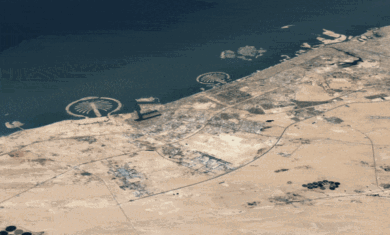When Google Earth was first released, there was talk about it everywhere and they were overwhelmed with downloads. Since then, it’s become more and more popular. However, I’m sure there are a lot of folks that downloaded it two years ago, checked it out a little bit, and then haven’t gone back in. Here’s what you’re missing now:
10. PhotoOverlays: In the latest release of Google Earth they now have PhotoOverlays – photos that seem to be hung in mid-air or wrapped around a sphere.
 9. Improved terrain: The 3D terrain in Google Earth is the main thing that separates it from Google Maps. You can tilt down and see the mountains and valleys in beautiful 3D. There is now an option to allow you to choose the terrain quality (lower=better performance, high=more eye candy).
9. Improved terrain: The 3D terrain in Google Earth is the main thing that separates it from Google Maps. You can tilt down and see the mountains and valleys in beautiful 3D. There is now an option to allow you to choose the terrain quality (lower=better performance, high=more eye candy).
8. Time animations: Starting with the beta version of GE4 you could have time animations — items that update as time rolls by. This can be for long periods (spread of Avian flu) or for short periods (“Blues Brother” car jumping a drawbridge).
7. New layers: Google Earth launched with an impressive collection of build-in layers. They’ve added tons more since then. My personal favorite is the “traffic” layer, which shows current traffic speeds in metro areas (Atlanta here). Dig into the layers and see all of the great new items in there.
 6. SpaceNavigator support: If you’ve not used this 3D mouse-ish tool, you have to try it. It makes Google Earth a whole new toy. Read more about this at the Google Earth Blog, or try to win one by using GEboards.
6. SpaceNavigator support: If you’ve not used this 3D mouse-ish tool, you have to try it. It makes Google Earth a whole new toy. Read more about this at the Google Earth Blog, or try to win one by using GEboards.
5. Flight simulator: For a while, it was fun to try to fake being a flight simulator in Google Earth by simply plugging in joystick. With the release of version 4.2, they included a hidden flight sim. Simply press [CTRL]-[ALT]-[A] (Command-Option-A on Mac) and you can choose to fly either an F16 or an SR22!
 4. Sky mode: Another great addition in version 4.2. By clicking the small “sky mode” button in Google Earth, you’ll be taken up to space and be shown the area exactly above where you were on the earth. You can browse, pan and zoom just as you would in earth mode, including support for the SpaceNavigator.
4. Sky mode: Another great addition in version 4.2. By clicking the small “sky mode” button in Google Earth, you’ll be taken up to space and be shown the area exactly above where you were on the earth. You can browse, pan and zoom just as you would in earth mode, including support for the SpaceNavigator.
3. Flash support: Google Earth now supports Flash animations inside of the description bubbles (Windows only, though). This has allowed for obvious things such as embedding YouTube videos, but also for less-obvious things such as creating Flash-based forms to allow for an in-Earth message board.
 2. 3D textures: When Google Earth first came out, people were amazed by the 3D buildings you could fly around. Problem was, they were all gray – solid, boring, gray. Since they, Google has built support for textures on the outside of buildings and the result is some cool looking cities. Denver, Colorado is probably the best example (it’s the home of SketchUp, the authoring tool for 3D models in Google Earth), so check it out.
2. 3D textures: When Google Earth first came out, people were amazed by the 3D buildings you could fly around. Problem was, they were all gray – solid, boring, gray. Since they, Google has built support for textures on the outside of buildings and the result is some cool looking cities. Denver, Colorado is probably the best example (it’s the home of SketchUp, the authoring tool for 3D models in Google Earth), so check it out.
1. Tons more imagery: Tons. Terabytes worth. Google has put out about eight huge imagery updates since they first released Google Earth, and each one has added thousands of square miles of fresh, higher quality images. Go check out your house again and you’ll probably find that it looks much better now than it did a few years ago.
There you go. 10 good reasons to go get the latest version of Google Earth and waste some time. If you’re looking for more fun stuff in Google Earth, go check out the huge KML file collection at Google Earth Hacks.


thanks!!!!!!!!!!!!!!!!!!!!!!!
very interesting, but I don’t agree with you
Idetrorce
Google Earth is the preferred way our customers view GPS tracking data. Unlike many digital street maps or text reporting features, Google Earth allows a more intimate and unique way to observe data. Not to mention, the good folks at Google offer the program for free!